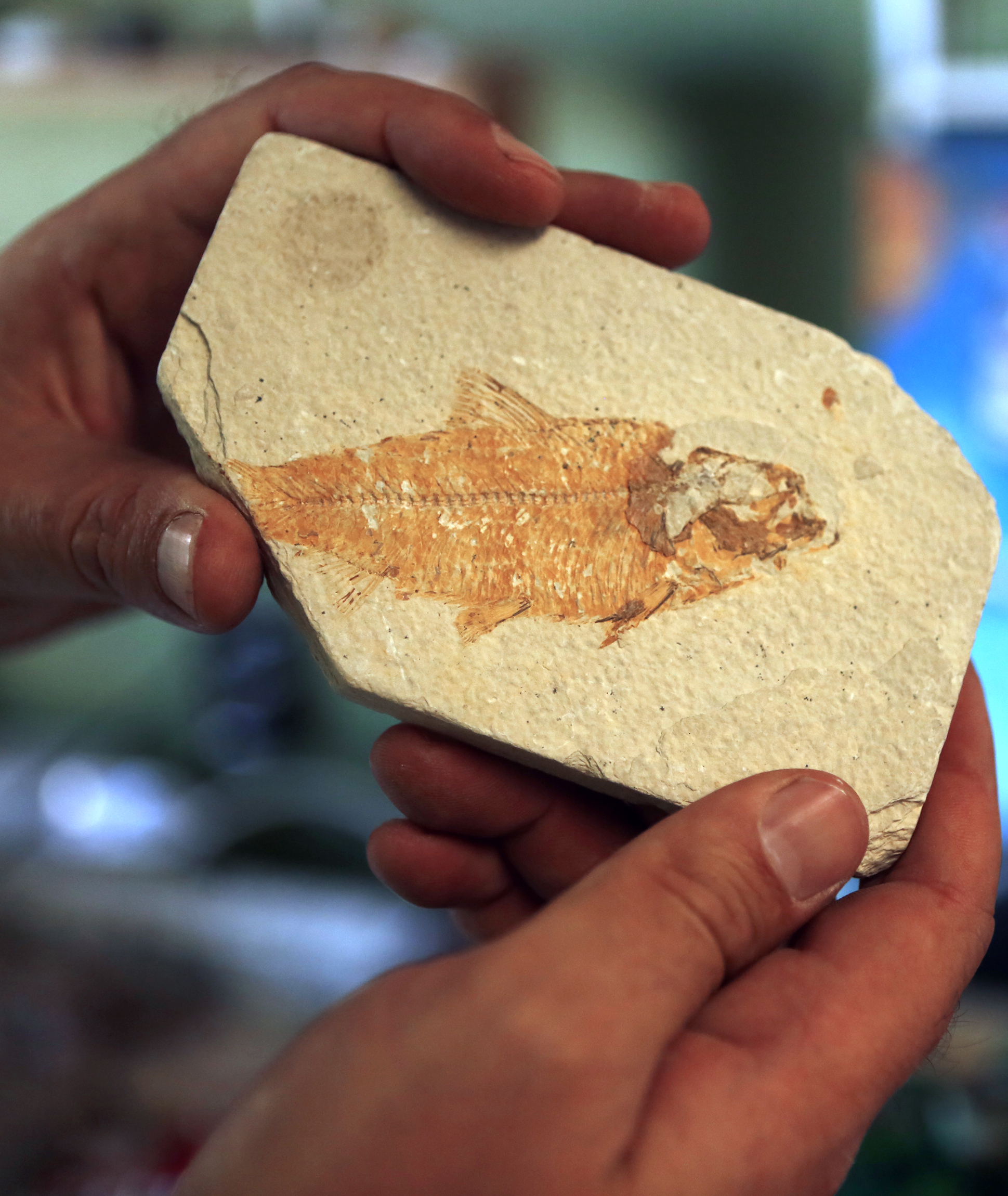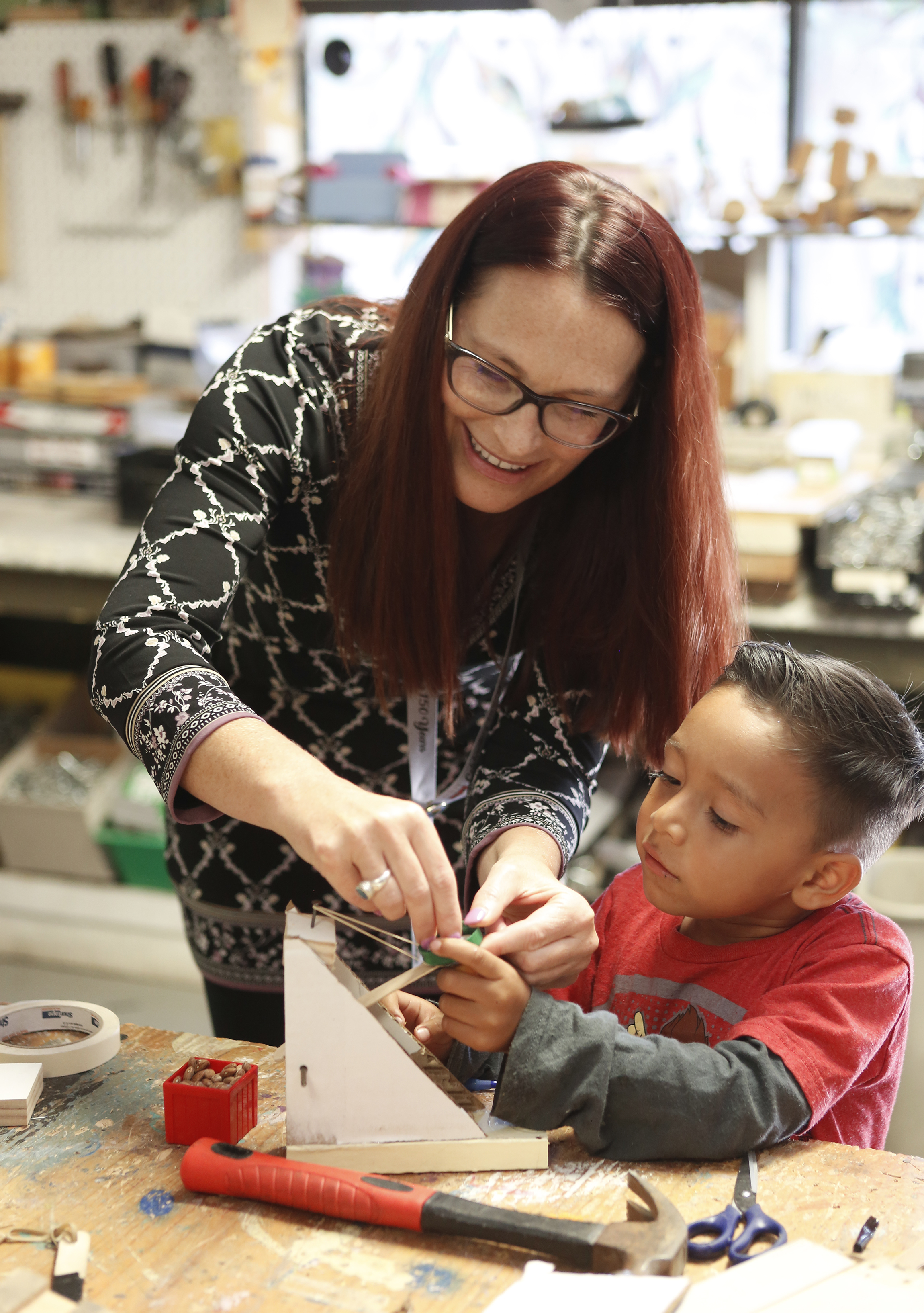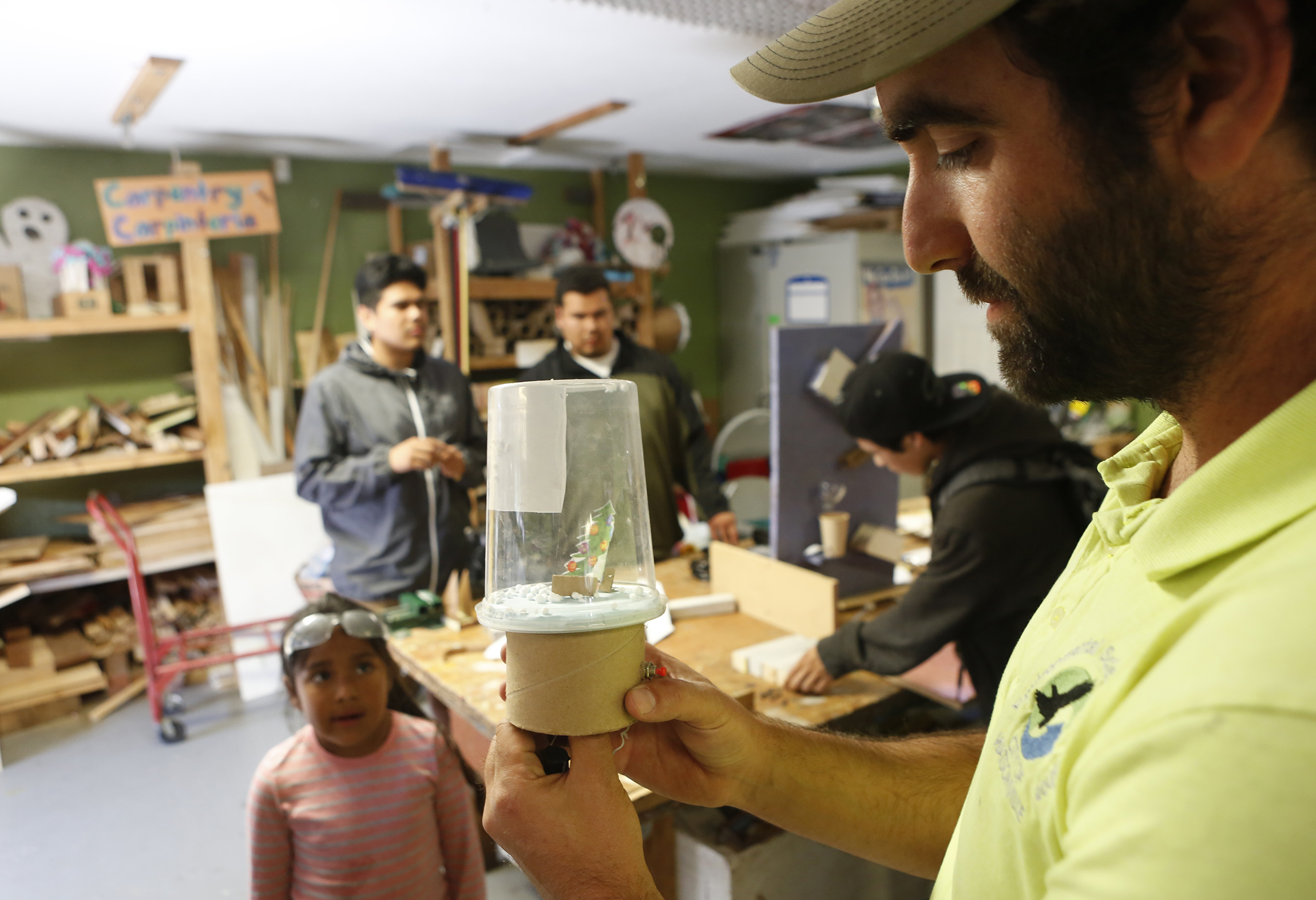By Kathryn McKenzie
There’s a kind of happy chaos that reigns in this after-school program in Watsonville, in a space that looks like a cross between a mad scientist’s lab and a carpenter’s shed. And if beans are flung across the room from the mini-catapults that the kids are making — well, you can’t make discoveries without a few things landing on the floor.
Four-year-old Matthew Espinosa giggles as he pulls back the catapult — built from rubber bands, Popsicle sticks and a plastic bottle cap — and watches the beans fly. He and the other children here are learning not just about scientific principles, but also about making their own toys, and having a blast in the process.
His sisters, 6-year-old Belle and 10-year-old Jenny, are making pinwheels out of construction paper, with the help of some of the aides and older kids. As soon as they’re done with those, they’re scanning the room to see what else they can do.
And that’s exactly the intent of the Watsonville Environmental Science Workshop — to let youngsters explore, tinker, and make whatever their hearts desire with the materials at hand.
“Every single inch of space is used,” says Darren Gertler as he leads a tour through the building on 2nd Street, about a block up from downtown Watsonville. The building contains everything from turtles in a glass aquarium to animal skulls to tool and sewing areas. Gertler now heads the program after founder Curt Gabrielson left several years ago. “It’s all started spiraling, but in a good way.”
Gertler is referring to the fact that similar programs are spreading throughout California, mainly in underserved, mostly Latino communities. The Watsonville program, now in its 21st year, was itself inspired by a San Francisco makers’ program, the Mission Science Workshop.

Gabrielson, a longtime science educator, convinced the Watsonville City Council in 1997 to provide space and funding for the workshop. He’s since gone on to the Asian nation of East Timor to provide similar opportunities to youth there.
“We get a lot of support from the city. They’re really passionate about this,” says Gertler.
And both Watsonville and the Mission workshop, in turn, begat the now 7-year-old Greenfield Community Science Workshop, headed by José Sanchez, a former volunteer and employee of the Watsonville program.
“The Greenfield CSW is very much modeled after the Watsonville ESW,” Sanchez writes via email. “I remember walking into the Watsonville ESW for the first time … I saw families and students of all ages interacting with the entire space. They were given the freedom to touch, use, and build whatever came to mind. Furthermore, the staff in charge looked like the participants, they spoke the preferred language of the participants, and lived in the same community as the participants.
“What I first saw at the Watsonville ESW as a genuine commitment to community science (emphasis on community), and that’s the main reason I decided that I wanted to bring the program to Greenfield.”
Both Watsonville and Greenfield also have mobile programs that regularly bring science and tinkering opportunities to local schools and other sites — in the case of Greenfield, to far-flung South Monterey County communities like San Ardo, San Lucas, King City and Soledad.
“Our programming has been very successful in each of these communities, almost too successful — lately, we have been forced to strategize about how manage large groups of students,” says Sanchez. “I think we may end up increasing the amount of staff in our mobile program given the popularity of the program.”

Why do kids need to tinker? In past eras, it was a given that children would acquire the skills they needed in life by being around adults and given opportunities and materials to build a go-cart, say, or to construct a simple toy on their own.
These days, materials such as wood, fabric and screws are expensive, parents are working or otherwise unavailable, and children don’t often get that chance to learn by doing.
Gertler says there are roughly 10,000 student interactions at the Watsonville workshop each year, a figure that includes students who visit more than once.
“Some will come, make a project, and go,” says Gertler. “Other will be here the whole four hours, help sweep up, and come back the next day, and the day after that.”
After signing in, kids are free to do whatever they like — build things, decorate them, sew costumes, fix their bikes, or work on school projects, all at no cost to them. All ages are welcome, although younger ones are carefully monitored by aides when working with certain tools, such as the scroll saw and the drill press.
Work areas are labeled in English and Spanish, including “Carpintería” — carpentry — and “Cosas Interesantes” — interesting things like plastic bottles and assorted throwaway items that can be put to creative uses.
Sewing is the most popular activity — “Lots and lots of costumes have been made here,” says Gertler — but building scooters from scrap wood and rollerblade wheels is also a top kid-driven project.
There are some ready-made projects that are available, and instructional aide Araceli Castillo shows one that she is putting together for a mobile program. It’s a homemade flashlight made from the foil inside of a potato chip bag, a recycled holiday mini-light, some wire and cardboard and two AA batteries.
“I started coming here with my two kids and I’d hang out with them here,” says Castillo. That was 16 years ago. Putting things together, she says, “that’s the fun part of this job.”

Materials like lumber and hardware are mostly donated by businesses and community members; funding for the workshop comes from the city and a variety of grants, Gertler says. He’s able to employ a number of adult aides as well as teens.
Two of these are Luis Granados and Jose Luis Rodriguez, both 17, who got hooked on the workshop when they came there to fix their bicycles a few years back.
When you ask Granados what he likes about the workshop, he says, “Everything — I like working with the tools, and helping the kids. I’m learning about a lot of different things, like engineering and science.”
Some workshop “graduates” do go on to college and to tech jobs, but the science workshops are not necessarily about preparing kids for science careers. Sanchez says he does work closely with the local school district to provide students with science enrichment, but “the Greenfield CSW is not in the business of pushing students through the STEM pipeline. At least not directly.
“Allowing students to do science in their own terms is also a wonderful way to inspire them to pursue a career that they are truly in passionate about … learning independently in an unstructured environment is a very effective way to figure out what really piques your interest.”
That was the case for another 17-year-old, Armando Tellez, who has been coming to the Watsonville workshop since he was 5 years old and his babysitter starting bringing him. He loves the animals there, and the camping trips that Gertler organizes, but plans to study creative pursuits when he gets out of high school — painting and culinary arts. Tellez says the thing he appreciates about the workshop is how it opened his eyes to the possibilities for his life.
“I’ve been coming every single day, and I’m still coming,” he says. “It’s a community, it’s where people interact.”
Have something to say about this story? Send us a letter.